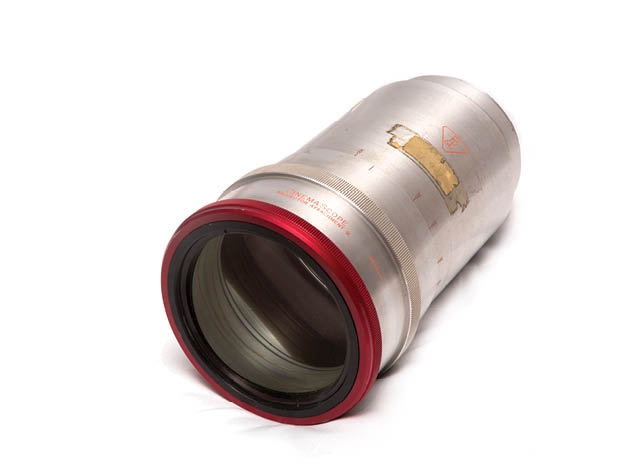Summer for many brings anticipation of summer blockbuster movies. A particular object that’s helped bring blockbusters to Edina audiences is tucked away in a cupboard at the Edina Historical Society. Its eye-catching red and black box contains a CinemaScope projector attachment lens once used at the Mann France Drive-In sometime between the theater’s opening in 1966 and its closing in 1982.
CinemaScope refers to a process that employs special lenses to compress the horizontal portions of an image to fit a standard film frame, typically 35 millimeters at the time. Another special lens in the film projector was used to expand the image onto the screen, restoring the original proportions and creating a widescreen experience for audiences. This process provided audiences with a heightened, more immersive experience than that provided by emerging television technology.
Before CinemaScope there was Cinerama, in which three projectors would display a film in three separate images projected in an interwoven fashion, or side by side, against a curved screen made of panels. The effect could be immersive and lush but also clunky, because panel seams would often show and the projection could be jittery. CinemaScope solved this problem by producing one large image, using the anamorphic lens created by Frenchman Henri Chrétien.
From France to Hollywood to a theater in Edina, CinemaScope, including the vintage lens at the Edina Historical Society, changed the way movies were made and viewed in the 1950s and beyond. This lens likely went unnoticed as pioneering technology back then. But today, it’s a fun reminder of those nights at an Edina drive-in under the stars with the smell of popcorn in the summer air.
Summer for many brings anticipation of summer blockbuster movies. A particular object that’s helped bring blockbusters to Edina audiences is tucked away in a cupboard at the Edina Historical Society. Its eye-catching red and black box contains a CinemaScope projector attachment lens once used at the Mann France Drive-In sometime between the theater’s opening in 1966 and its closing in 1982.
CinemaScope refers to a process that employs special lenses to compress the horizontal portions of an image to fit a standard film frame, typically 35 millimeters at the time. Another special lens in the film projector was used to expand the image onto the screen, restoring the original proportions and creating a widescreen experience for audiences. This process provided audiences with a heightened, more immersive experience than that provided by emerging television technology.
Before CinemaScope there was Cinerama, in which three projectors would display a film in three separate images projected in an interwoven fashion, or side by side, against a curved screen made of panels. The effect could be immersive and lush but also clunky, because panel seams would often show and the projection could be jittery. CinemaScope solved this problem by producing one large image, using the anamorphic lens created by Frenchman Henri Chrétien.
From France to Hollywood to a theater in Edina, CinemaScope, including the vintage lens at the Edina Historical Society, changed the way movies were made and viewed in the 1950s and beyond. This lens likely went unnoticed as pioneering technology back then. But today, it’s a fun reminder of those nights at an Edina drive-in under the stars with the smell of popcorn in the summer air.










